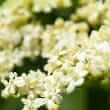Background
- Several species of Sambucus produce elderberries. Most research and publications refer to Sambucus nigra. Other species with similar chemical components include the American elder or common elder (Sambucus canadensis), antelope brush (Sambucus tridentata), blue elderberry (Sambucus caerulea), danewort (Sambucus ebulus), dwarf elder (Sambucus ebulus), red-fruited elder (Sambucus pubens, Sambucus racemosa), and Sambucus formosana. American elder (Sambucus canadensis) and European elder (Sambucus nigra) are often discussed simultaneously in the literature since they have many of the same uses and contain common constituents.
- European elder grows up to 30 feet tall, is native to Europe, but has been naturalized to the Americas. Historically, the flowers and leaves have been used for pain relief, swelling/inflammation, diuresis (urine production), and as a diaphoretic or expectorant. The leaves have been used externally for sitz baths. The bark, when aged, has been used as a diuretic, laxative, or emetic (to induce vomiting). The berries have been used traditionally in food as flavoring and in the preparation of elderberry wine and pies.
- The flowers and berries (blue/black only) are used most often medicinally. They contain flavonoids, which are found to possess a variety of actions, including antioxidant and immunologic properties. Although hypothesized to be beneficial, there is no definitive evidence from well-conducted human clinical trials currently available regarding the use of elder.
- The bark, leaves, seeds, and raw/unripe fruit contain the cyanogenic glycoside sambunigrin, which is potentially toxic.
References
Natural Standard developed the above evidence-based information based on a thorough systematic review of the available scientific articles. For comprehensive information about alternative and complementary therapies on the professional level, go to . Selected references are listed below.
- Barak V, Birkenfeld S, Halperin T, et al. The effect of herbal remedies on the production of human inflammatory and anti-inflammatory cytokines. Isr Med Assoc J 2002;4(11 Suppl):919-922.
View Abstract - Bitsch I, Janssen M, Netzel M, et al. Bioavailability of anthocyanidin-3-glycosides following consumption of elderberry extract and blackcurrant juice. Int J Clin Pharmacol Ther 2004;42(5):293-300.
View Abstract - Ernst E, Marz RW, Sieder C. [Acute bronchitis: effectiveness of Sinupret. Comparative study with common expectorants in 3,187 patients]. Fortschr Med 4-20-1997;115(11):52-53.
View Abstract - Forster-Waldl E, Marchetti M, Scholl I, et al. Type I allergy to elderberry (Sambucus nigra) is elicited by a 33.2 kDa allergen with significant homology to ribosomal inactivating proteins. Clin Exp Allergy 2003;33(12):1703-1710.
View Abstract - Guo CT, Takahashi N, Yagi H, et al. The quail and chicken intestine have sialyl-galactose sugar chains responsible for the binding of influenza A viruses to human type receptors. Glycobiology 2007 Jul;17(7):713-24.
View Abstract - Gray AM, Abdel-Wahab YH, Flatt PR. The traditional plant treatment, Sambucus nigra (elder), exhibits insulin-like and insulin-releasing actions in vitro. J Nutr 2000;130(1):15-20.
View Abstract - Hassid S, Choufani G, Nagy N, et al. Quantitative glycohistochemical characterization of normal nasal mucosa, and of single as opposed to massive nasal polyps. Ann Otol Rhinol Laryngol 1999;108(8):797-805.
View Abstract - Jaber R. Respiratory and allergic diseases: from upper respiratory tract infections to asthma. Prim.Care 2002;29(2):231-261.
View Abstract - Konlee M. A new triple combination therapy. Posit Health News 1998;(No 17):12-14.
View Abstract - Milbury PE, Cao G, Prior RL, et al. Bioavailablility of elderberry anthocyanins. Mech Ageing Dev. 4-30-2002;123(8):997-1006.
View Abstract - Neubauer N, März RW. Placebo-controlled, randomized double-blind clinical trial with Sinupret® sugar coated tablets on the basis of a therapy with antibiotics and decongestant nasal drops in acute sinusitis. Phytomedicine 1994;1:177-181.
- Richstein A, Mann W. [Treatment of chronic sinusitis with Sinupret]. Ther Ggw 1980;119(9):1055-1060.
View Abstract - Roy S, Khanna S, Alessio HM, et al. Anti-angiogenic property of edible berries. Free Radic Res. 2002;36(9):1023-1031.
View Abstract - Wu X, Cao G, Prior RL. Absorption and metabolism of anthocyanins in elderly women after consumption of elderberry or blueberry. J.Nutr 2002;132(7):1865-1871.
View Abstract - Zakay-Rones Z, Thom E, Wollan T, et al. Randomized study of the efficacy and safety of oral elderberry extract in the treatment of influenza A and B virus infections. J Int Med Res 2004;32(2):132-140.
View Abstract







